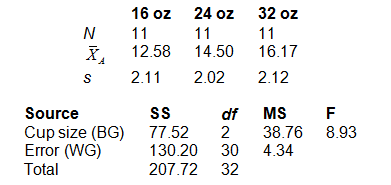You decide to conduct the analytical comparison of 16 oz vs. 24 oz. Which of the following is the appropriate critical value for this analytical comparison?
As there is a growing concern about alcohol-related problems on college campuses, a team of researchers was interested in studying students’ perceptions about alcohol consumption—more specifically, in how students define a “drink” (White et al, 2004).
These researchers were interested in seeing whether the size of a cup influences how much beer students will pour into the cup. In their study students poured what they believed were 12 ounces of beer into one of three cups of different sizes (16, 24, or 32 ounces). They hypothesized that the larger the cup, the more beer students would pour. The results of their analyses are presented below:

a. 4.32
b. 4.30
c. 4.26
d. 4.17
d. 4.17
You might also like to view...
The fact that people may learn from test taking is an experimental validity threat known as ____; the fact that the measurement scale may change over the course of the experiment is called ____
a. instrumentation; testing effect c. testing effect; instrumentation b. maturation; testing effect d. instrumentation; selection
When is an operational definition needed?
a. When you measure the length of a desk b. When you decide what is meant by a “broken egg” c. When you weigh a balloon before and after blowing it up d. When you calculate the period of a pendulum e. All of the above f. None of the above
What steps might be taken to get the most benefit from an informal reading inventory?
What will be an ideal response?
Answer the following statement(s) true (T) or false (F)
1. In giving feedback, addressing behaviors refers to focusing on personal traits. 2. Norms are the rules of behaviors that are established and shared only by some members of the group. 3. Cohesiveness is described as a sense of “we-ness,” the cement that holds a group together. 4. Norms are not useful in figuring out what is appropriate or inappropriate in a group setting. 5. Providing structure for a group is like giving members an architectural blueprint for their work.